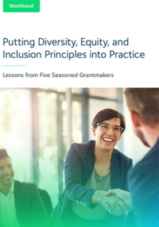Trends in Grantmaking: Putting Equitable Grantmaking into Practice

Having a diverse, equitable, and inclusive workspace is the right thing to do. But above that, the evidence is irrefutable: a more diverse and inclusive organization is a better-performing organization. McKinsey, Gartner, and DNV have all come to the same conclusion.
Organizations working toward social impact know this better than most industries. But for grantmaking organizations, the DEI effort is two-fold. Not only do you need to look inward at your own operations, but you also need to make sure your funding reflects those same goals.
For grantmakers to make a truly lasting impact across their community, they need to be intentional about their equity and inclusion practices, both within their organization and with their funding efforts.
Equitable grantmaking is a trend that we expect to impact grantmaking for years to come. Learn about the others in our blog post, 5 Trends in Grantmaking that We Think Have Staying Power.
Being Intentional about Equity in Grantmaking
Equity and inclusion are not boxes to be checked. It’s a continued effort that touches every part of your grantmaking, from the vendors you choose, to your hiring practices, to the information you collect about your grantees.
Reviewing Internal Processes for Equity
The first place to start is internally with your organization’s operations. Yes, training on empathy and recognizing bias is important, but it needs to go deeper. How are you recruiting staff and volunteers? If you aren’t seeing a diverse set of applicants, is there something in the way the job description is written or the places where it is advertised that should be reconsidered?
During our webinar on DEI in practice, Rhett Mabry, President at The Duke Endowment shared how they needed to think about their recruitment process differently. “We require a diverse pool of candidates, so we had to develop new connections and relationships in the community so we could find candidates we didn’t reach in the past,” Rhett said.
As an organization that hires vendors to help with aspects of your day-to-day management, vendor selection is another way to be intentional about equity. Also on the DEI in Practice webinar, Tonia Wellons, President and CEO at the Greater Washington Community Foundation, explained the process they went through to find an investment management firm for their endowment that aligned on prioritizing women- and minority-led organizations.
Updating Your Grantmaking Process with an Equity Lens
Ensuring your grantmaking organization creates opportunities for all nonprofits in your impact area can take planning and intentionality. There is a fine line between an onerous application that gets you all the information you need (and more) and an easy-to-complete application that leaves a lot of blank fields in your database.
Spend time thinking through the specific information that you need to collect, and when you need to have it. You might want to know the geographic location a grantee serves, but you might not need to know their annual revenue until later in the process—or at all. Review your applications through an equity lens after each grant cycle. Look for ways to add specificity and remove complexity. As Tonia shared on the webinar, “Simple applications well-considered can help you make rapid decisions.”
 Free Resource
Free Resource
Guidance from Grantmakers
Evaluate Putting Diversity, Equity, and Inclusion Principles into Practice

Using Your Grant Management Software to Support Equitable Grantmaking
By understanding the information you want to collect and the metrics you want to see, you can set up systems to help support your equity and inclusion efforts.
Louisa Robinson, Business Analyst for the Paul Hamlyn Foundation, shared during a webinar on Modern Grantmaking that they started making a concerted effort to collect diversity information from their grantees in 2020. In 2022, they realized they needed to be more detailed, and updated their application to ask about the communities the organizations served and break out the diversity of their leadership and trustees, instead of their staff as a whole.
With applications that feed directly into the grants management system, funders can easily run reports to see if they are meeting their goals for a diverse set of grantees. And if they aren’t getting applications from the organizations they want to see more of—such as minority-led or reaching refugee communities, for example—they can do the work to close that gap.
These changes not only gave them the data to make sure their funding matched their equity commitment but also encouraged them to look at their internal controls. With more—and potentially sensitive—information in their grants management system, they needed to revisit who had access to which fields and what information could potentially be made public.
How Grantmakers Are Putting Equity Principles into Action
Though most foundations and grantmaking organizations have spent several years working toward more diversity, equity, and inclusion in their practices, it’s still a complex and evolving process.
When Blackbaud’s Manager of Global Social Responsibility Melissa Furr hosted a conversation with philanthropy experts Tonia Wellons, President and CEO at the Greater Washington Community Foundation; Rhett Mabry, President at The Duke Endowment; and Michael Boulware Moore, VP of Diversity and Inclusion at Blackbaud, they explored what actions their organizations are taking to put equity into practice. And how it was a continual journey.
Keep Your Organization Accountable with Clear Reporting
With accurate and streamlined reporting options from your grants management system, you can easily see where you are compared to your goals. Whether you are measuring the number of organizations you reach by impact area or tracking the percentage of minority-led nonprofits you support, use your grants management system to keep your organization accountable to your goals.
Learn more about reporting options with your GMS by downloading our whitepaper, 3 Ways Dashboards Help Grantmakers Make Sense of Their Data.



